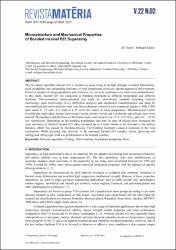| dc.contributor.author | Günen, Ali | |
| dc.contributor.author | Kanca, Erdoğan | |
| dc.date.accessioned | 12.07.201910:50:10 | |
| dc.date.accessioned | 2019-07-12T22:06:58Z | |
| dc.date.available | 12.07.201910:50:10 | |
| dc.date.available | 2019-07-12T22:06:58Z | |
| dc.date.issued | 2017 | |
| dc.identifier.citation | Gunen, A., Kanca, E. (2017). Microstructure and mechanical properties of borided inconel 625 superalloy. Revista Materia
22(2), e11829. doi: 10.1590/S1517-707620170002.0161 | en_US |
| dc.identifier.issn | 1517-7076 | |
| dc.identifier.uri | https://doi.org/10.1590/S1517-707620170002.0161 | |
| dc.identifier.uri | https://hdl.handle.net/20.500.12508/818 | |
| dc.description | WOS: 000404484300001 | en_US |
| dc.description | Science Citation Index Expanded | en_US |
| dc.description.abstract | The Ni-based superalloy Inconel 625 is extensively used owing to its high strength, excellent fabricability, good weldability and outstanding resistance to high temperature corrosion against aggressive environments. However, despite its unique properties and extensive use, its wear resistance is in some cases unsatisfactory. In this study, Inconel 625 was subjected to boriding treatments at different temperature and different durations. Microstructural characterization was made by conventional methods (scanning electron microscopy, optic microscopy, X-ray diffraction analysis) and mechanical characterization was made by microhardness and micro-abrasion wear test. Micro-abrasion wear tests were conducted against a AISI 52100 steel under 5, 7.5 and 10 N load in a 25 wt.% SiC slurry at room temperature. Microstructural results revealed that multi-phase boride layer (nickel boride, chrome boride and iron boride) and silicide layer were formed. The hardness and thickness of the boride layers were found to be 1175-2432 HV0.1 and, 6.61 - 92.03 mu m, respectively. Depending on the boriding temperature and time. In spite of silicide layer formation the wear resistance of borided Inconel 625 alloy increased up to 8 times thanks to the increase in the surface hardness which was caused by boriding process. The boriding treatment caused a transition in the wear mechanism. While grooving was observed in the untreated Inconel 625 samples, mixed (grooving and rolling) and rolling type wear was predominant in the borided samples. | en_US |
| dc.description.sponsorship | Mustafa Kemal University Research Council [13911]; Mustafa Kemal University Research Council | en_US |
| dc.description.sponsorship | This study was supported by the Mustafa Kemal University Research Council (Project Number 13911). The authors wish to thank Mustafa Kemal University Research Council for its grant contributions to this study. | en_US |
| dc.language.iso | eng | en_US |
| dc.publisher | Universidade Federal do Rio de Janeiro | en_US |
| dc.relation.isversionof | 10.1590/S1517-707620170002.0161 | en_US |
| dc.rights | info:eu-repo/semantics/openAccess | en_US |
| dc.subject | Ni-Based Superalloy | en_US |
| dc.subject | Coating | en_US |
| dc.subject | Microstructure | en_US |
| dc.subject | Mechanical Properties | en_US |
| dc.subject | Wear | en_US |
| dc.subject.classification | Borides | Boriding | Boride layers | en_US |
| dc.subject.classification | Materials Science, Multidisciplinary | en_US |
| dc.subject.other | wear behavior | en_US |
| dc.subject.other | coatings | en_US |
| dc.title | Microstructure and mechanical properties of borided inconel 625 superalloy | en_US |
| dc.type | article | en_US |
| dc.relation.journal | Revista Materia | en_US |
| dc.relation.journal | Materia-Rio de Janeiro | en_US |
| dc.contributor.department | Mühendislik ve Doğa Bilimleri Fakültesi | en_US |
| dc.identifier.volume | 22 | en_US |
| dc.identifier.issue | 2 | en_US |
| dc.relation.publicationcategory | Makale - Uluslararası Hakemli Dergi - Kurum Öğretim Elemanı | en_US |
| dc.contributor.isteauthor | Günen, Ali | |
| dc.contributor.isteauthor | Kanca, Erdoğan | |
| dc.relation.index | Web of Science (ESCI) - Scopus | en_US |
















